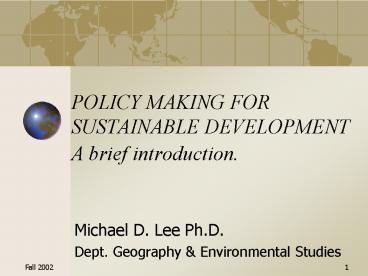POLICY MAKING FOR SUSTAINABLE DEVELOPMENT A brief introduction. - PowerPoint PPT Presentation
1 / 9
Title:
POLICY MAKING FOR SUSTAINABLE DEVELOPMENT A brief introduction.
Description:
... to require only 1.6 gallon toilets be sold in California and making ... to perverse conditions (e.g. China's infanticide/selective abortions of girls) ... – PowerPoint PPT presentation
Number of Views:50
Avg rating:3.0/5.0
Title: POLICY MAKING FOR SUSTAINABLE DEVELOPMENT A brief introduction.
1
POLICY MAKING FOR SUSTAINABLE DEVELOPMENTA brief
introduction.
- Michael D. Lee Ph.D.
- Dept. Geography Environmental Studies
2
Policy and its purpose
- A public policy is a pattern of governmental
activity on some issue that has a purpose or
goal. - A sustainable development policy is a conscious
decision to adopt a particular strategy or
practice within a program of development (urban,
industry, agricultural and so forth) that can
yield positive benefits for a given populace and
be maintained over time while at the same time
avoiding or minimizing negative effects at a
broader scale. - Policys must articulate both the ends and the
means i.e. state the set of objectives and
prescribe the ways in which those objectives are
to be achieved.
3
Policymaking
- Policies are made, i.e. they are formulated - by
policy makers. - In democracies, public policy makers are usually
elected officials, or appointees of elected
officials, e.g. Congressmen, Senators, Governors
or their Appointees EPA Director, Secretary of
Energy, etc. - In the private sector, policy makers are CEOs and
Boards of Directors and other top-ranking
corporate officials. - Policy Makers are influenced by special
interests, entities who do not have the power to
make or enforce policy themselves but
nevertheless seek to help establish what a
particular policy will be out of their own
interests or for the interests of third parties.
4
External Influences on Policy Making
- Special interests are lobbyists, political action
committees, individual/corporate donors,
non-Governmental organizations, protest groups
and so forth. They use access, money, publicity,
even violence to influence policy makers. - A third group important in setting policy are the
technical advisors, sometimes called social
agents, that perform a (supposedly) impartial
function in advising and informing policy makers
on the likely effects of their policies. - In democratic settings, a forth group that
influences decisions are the general public, who
are frequently consulted to comment on policies
that affect them before final decisions are made.
5
Policies a basis for judgment
- Once declared, a policy becomes a set of guiding
principles that are used to shape what we do and
become standards by which we and others can judge
our behavior and performance. - Whether a public policy is followed and
effectively implemented depends on a variety of
factors including - who is the actor?
- whether they stand to gain or lose from the
required actions? - whether the implementation of required actions is
monitored and if so, whether they are enforced? - whether enforcement is based on sanctions or
inducements sufficiently large to motivate
compliance?
6
Policies and Practices
- Sustainable development policies dictate what
governments must do and what citizens and
corporations must do to protect the public
interest and promote welfare for present and
future generations, usually also safeguarding the
interests and welfare of others affected by the
policies. - Frequently, for economic or ideological reasons,
particular entities (nations, corporations,
individuals, etc.) will seek to avoid
implementing the actions necessary to achieve the
policy objectives with which they must comply,
especially when incentives are weak. - Thus effective policy frequently needs to be
accompanied by enforcement. - Enforcement is commonly the weakest element in
the policy process, leading to failed
implementation.
7
Examples of SD policies?
- Without passing value judgments, here are some
policies that might be considered SD examples - Swedens tax structure changing from taxing wages
to taxing consumption, especially consumption
with high external costs (e.g. carbon taxes on
energy). - Chinas demographic policy of promoting 1 child
per couple through incentives/disincentives. - Californias policy to require only 1.6 gallon
toilets be sold in California and making these
mandatory as part of the Uniform Plumbing Code. - Clearly, some policies may be imperfect in that
they may lead to perverse conditions (e.g.
Chinas infanticide/selective abortions of
girls). - Policies should be viewed as to their overall
impacts from a social, economic and environmental
perspective and balanced as best as possible.
8
The sustainability triangle ()
0
100
The
Environmental goals
Economic goals
50
50
Redrawn as a graph.
The policy sweet spot
0
100
100
0
50
Social goals
Each axis of the sustainability triangle shows
the degree to which economic, social and
environmental goals are being satisfied. Due to
trade-offs between each, no single aspect can be
maximized, so instead, any policy outcome must
provide a balance (hit the sweet spot!).
9
Relevant Reading (among others)
- Assigned reading Integrating Economy, Society,
and Environment through Policy Assessment. Peter
Boothroyd. Pages 130-165 in Woollard I. et al
2000. Fatal Consumption. UBC Press, Vancouver. - Optional reading(request a copy from M. Lee if
you are interested) - Environmental Policy Making What have economic
analysis and the idea of sustainability got to
offer? Paul Ekins. Pages 35-57 in Redclift M.
(ed) 2000. Sustainability Life Chances and
Livelihoods. Routledge Sahl J.D. and Bernstein
B.B. 1995. Developing policy in an uncertain
world. Int. J. Sustain. Dev. World Ecol. 2 (1995)
124-135. - Various chapters in Rao P.K. 1999. Sustainable
Development Economics and Policy. Blackwell
Publishers, London. and/or Moffatt I. 1996.
Sustainable Development Principles, Analysis and
Policies. Parthenon Publishing, New York.































